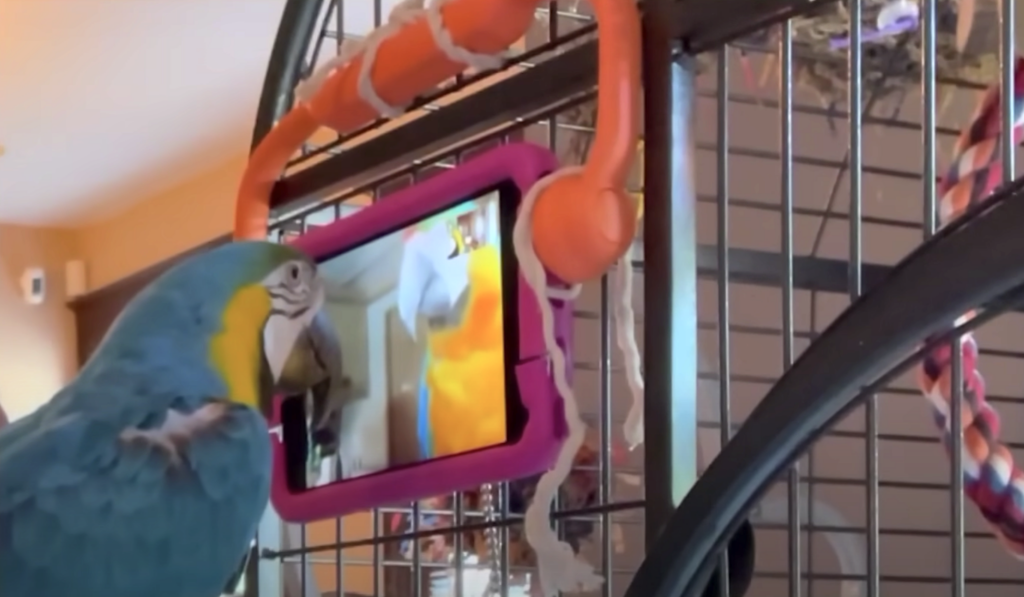It’s telling that the avian participants in a recent study wherein pet parrots, assisted by their owners, learned to make video calls to others of their kind were recruited from the online educational forum Parrot Kindergarten.
In the above footage, the humans’ hopeful, high-pitched cajoling, as they encourage their birds to interact with a new “friend”, carries a strong whiff of those Mommy and Me classes where a dozen or so adults sit crosslegged in a circle, shaking tambourines and brightly warbling “Twinkle, Twinkle, Little Star,” while an equal number of toddlers wander around, markedly less invested in the proceedings.
Though, really, who am I to judge? I don’t have a parrot, and it’s been over two decades since my youngest child required parental interference to foment social interaction…
Eighteen pet parrots enrolled in the study, hanging out with one another during self-initiated video chats, to see how and if such interactions might improve their quality of life.
No one was forced to make a call if they weren’t feeling it, or to remain on the line after their interest flagged.
I’m hunching the average parrot’s preoccupation with modern technology clocks in far south of the average American toddler’s, which may explain why they completed a mere 147 calls over the course of two months (and 1000 hours of combined footage.)
That said, I can easily imagine a scenario in which the average human toddler, having successfully gotten their beak, excuse me, hands on a touchscreen tablet, loses all interest in FaceTiming with a peer, preferring the solitary pleasures of Balloon Pop or Peek-a-Zoo.
Typically, human toddlers have more opportunities for “interspecies ethical enrichment” than creatures whose lives are primarily spent in a cage. As the authors of the study note, “over 20 million parrots are kept as pets in the US, often lacking appropriate stimuli to meet their high social, cognitive, and emotional needs.”
The parrot participants may not have thrown themselves into the proceedings with the vigor of Bye Bye Birdie’s teenaged telephone chorus, but all placed calls, the majority exhibited “high motivation and intentionality”, and their humans indicated that they would gladly continue to facilitate this social experiment.
The human contribution is not inconsiderable here. It took vast amounts of time and patience to orient the birds to the system, and careful monitoring to make sure calls didn’t run off the rails. Nothing like having your iPad screen smashed by a parrot who’s got beef in an online forum…
Several legit friendships formed over the course of the experiment – a Goffin’s cockatoo and an African grey who made each other’s virtual acquaintance during the pilot study were still chatting, a year after they met.
Data collected in the field shows that the number and duration of outgoing calls were closely tied to the number and duration of incoming calls. The most popular birdies did not take their connections for granted.
It’s a finding humans would do well to absorb if we are to combat feelings of isolation from within our own species.
Read Birds of a Feather Video-Flock Together: Design and Evaluation of an Agency-Based Parrot-to-Parrot Video-Calling System for Interspecies Ethical Enrichment here.
Related Content
What Kind of Bird Is That?: A Free App From Cornell Will Give You the Answer
Cornell Launches Archive of 150,000 Bird Calls and Animal Sounds, with Recordings Going Back to 1929
Parrot Sings AC/DCs “Whole Lotta Rosie”
– Ayun Halliday is the Chief Primatologist of the East Village Inky zine and author, most recently, of Creative, Not Famous: The Small Potato Manifesto and Creative, Not Famous Activity Book. Follow her @AyunHalliday.
